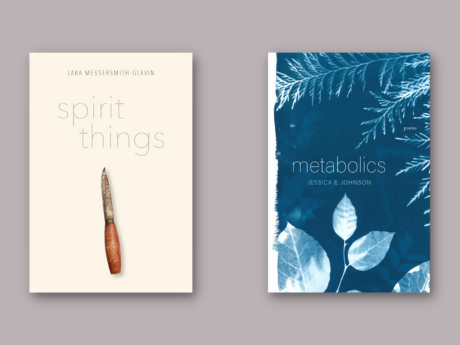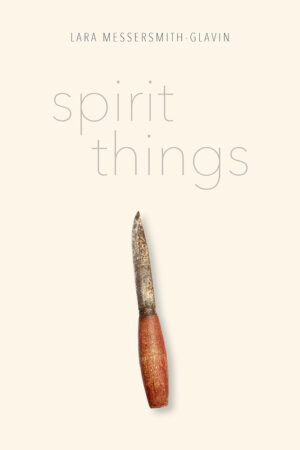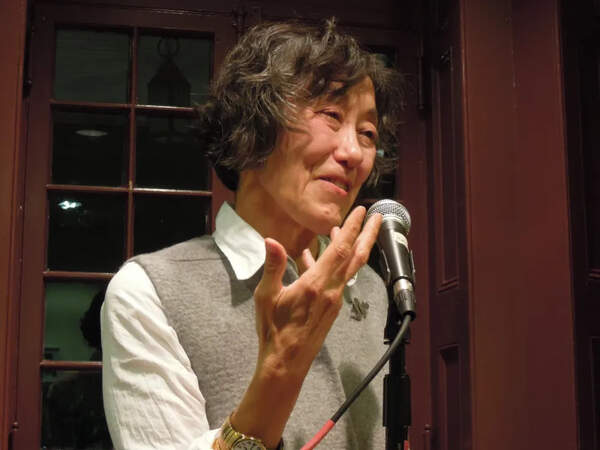Interviews
Finding Form in the Space Between Genres: Two Pacific Northwest Writers Talk Pattern-Seeking, Poetry, Science, Wildness, and Way-finding


Jessica E. Johnson writes poetry, nonfiction, and things in between. An Oregon Literary Fellowship recipient and an Oregon Book Award finalist for In Absolutes We Seek Each Other, she is the author of the book-length poem Metabolics, a study in the ecologies of contemporary parenting that borrows the language of metabolic pathways to construct an allegory about a family in the Pacific Northwest. She lives in Portland.
Lara Messersmith-Glavin is the author of Spirit Things, a collection of essays exploring the secret histories, science, and mythology of objects on a fishing boat in Alaska, which was nominated for the Willa Cather Award and listed as a Top Read of 2022 by the Anchorage Daily News. Her nonfiction writing has appeared in numerous journals and anthologies, and she has fiction projects in the works. She also lives in Portland.
In February of 2023, anticipating the release of Metabolics and the audiobook version of Spirit Things, they recorded a conversation about their books, their backgrounds, and their creative processes. This conversation was later edited for length and clarity.
JEJ: One point of connection between our books is they’re between genres. Metabolics is a poem that borrows from science textbooks, and Spirit Things, I notice, does not have a genre designation on the cover or spine, although the back cover copy says it’s an essay collection–and you’ve said it’s often mistaken for poetry. Lara, how did you arrive at the form of the book, where each essay centers around an object?
LMG: Yeah, the way that the book is organized, it looks like a series of essays, and the chapter titles reflect that. Each piece is looking at the material and social and personal histories of individual objects, but taken as a whole, it acts more like a broader memoir, written largely about my childhood.
I think it is often mistaken for poetry because I first started writing about Alaska and doing a lot of this kind of work through the Fisher Poets Gathering, which happens every year in Astoria [Oregon]. It's this wonderful folk art festival, where people from commercial fisheries around the world, but mostly from the Pacific Northwest, come together and share poetry and music and storytelling and art, and many of the pieces that ended up being in this collection were originally pieces that I performed there live. These spoken word performances were created with this lyric history in mind. When they made their way into this more concrete collection, that voice continued. There's going to be an audiobook version of the text coming out sometime in spring of 2023, which is the way I think it was always intended to be experienced.
Having the Fisher Poets thing hanging over it, people are always asking, “What are
you exactly?” In that [Fisher Poets] context, people often say, “Oh, I really liked your poem,” even though I don't ever think of it as that.
It seems like your work has kind of the opposite experience, where you are writing poetry, and you have developed a poetics that closely reflects your fascinations with science, as well as your work in an academic context. And so you have in some places intersections with textbook language and imagery. I'd love to hear about that.
JEJ: Another point of similarity is that Metabolics also began in a specific literary community–in a writers group that I was doing in the Women's Resource Center at the college where I teach. The students in the group at that time happened to be science students, and they were elaborating on the aesthetics of science, how interesting and beautiful science is and how they could sustain their interest in an aesthetic way, even when the studying part was drudgery.
We had a practice of writing for ten minutes and then sharing, and that’s when I decided to experiment a little bit with some prose poems inspired by the motions of biochemical pathways, where one component is reacting with the next component. I wanted to see if I could write that motion in a way that the students would be able to hear and appreciate. It was their early appreciation that made me feel like I wanted to pursue this project. It was also something I could do in small pieces of time.
So I began daily practice in which I was really trying to imagine the motions of transformation.
I wanted to imagine these motions not from a detached perspective, but right from within the deeply entangled reality of my life, and its objects and creatures and trees. I wrote these prose blocks where each element is consuming something else, and perhaps generating energy, and perhaps consuming energy. And over the collection what's hopefully conveyed is some form of transformation that we carry within ourselves.
LMG: So once you had that central concept, what did it feel like then, to be rediscovering your daily life through that lens? Did the actual transformation have something to do with your understanding of not just that process, but what you were trying to explore through it? What was that like?
JEJ: The semi-detached voice allowed defamiliarization, and I think this is where the transformation starts. In the poems you're seeing clouds and the weird things they do. Children and the weird things they do. Cats and the weird things they do, and you’re seeing all this through a pseudo-detached, faux-clinical lens. The detachment-–which is really the pose of detachment—allows the everyday to become strange. The strangeness allowed me to feel these things more intensely and also unlocked a kind of humor in the situation that I I enjoyed. Over the course of the book, the transformation starts with defamiliarization and ends in the relief of being able to imagine yourself as part of something larger that you don't control or understand.
LMG: The impact of that, I think, is really clear in your work. I'm glad that you mentioned the humor, because that was something that really stood out to me. I think the cat was where I felt that most strongly in the work; being able to examine the activities of the cat or of the child with this kind of distance allowed for that general absurdity to also creep in, and that was really very charming. It's an aspect of the book that I appreciate a lot.
JEJ: I want to note the humor in Spirit Things too, before we leave that topic. This book is so rich with the details of time and place, as you experienced it but also in the stories that you received as a child of your parents. I'm curious about how the structure you chose for the collection let in this range of memory and tone from the serious to the actually quite funny to the compellingly concrete and sensory.
LMG: This is something that has taken me a while to figure out about my own writing and about what I want to do with work. I've always struggled with this idea that I was supposed to tell a story, and the idea of what a narrative is supposed to look like, or what a plot trajectory is supposed to look like, for instance.
There's a real culture around storytelling, and especially in a commercial environment like [fishing in] Alaska, there are certain kinds of stories that get told, and they're usually around, you know, huge catches or great disasters, super badass individuals, or crazy people.
And writing about those things was a real challenge for me, for a couple of reasons. One, it's not really how my mind works. I don't find those stories very compelling, and I don't remember them. And the other is that I was a kid through most of my experience there, and so I was connecting to the environment in a very different way. I wasn't aware of a lot of the politics, for instance, I wasn't aware of a lot of the interpersonal dramas that might have been going on.
When I sat down to try to excavate these memories, I asked myself, “Well, what are the stories that I have to tell?” I found that I had to really let go of a lot of this stuff that I thought people wanted to hear about.
When I chose this pattern of just focusing on the objects, I found that it was an incredibly powerful back door to a huge trove of sensory memory that I didn't realize that I had access to. It's almost like a trick to get into a trance, especially if I had a similar object that I could hold. I've been reading a lot about how memory and place are connected, and how we can trigger memories that we didn't know we held by being in a physical location, and I think you can do something similar sometimes with objects. So I didn't always know what I would find. I didn't know if the stories that would come up were going to be funny, or sad, or something else.
I think for me the centering on the objects was, on the one hand, a way to short circuit the need to tell a traditional narrative. And it was also this back door into being able to get at a lot of what might have otherwise remained buried memories, sensory and otherwise.
And then, of course, I really love working with symbolic objects. [This process] gave me a little bit of space to look at what are the symbolic layers and what are the historical layers of a net or a wave, for instance. And so it allowed me to be both very literal and also completely symbolic and detached in these different ways, which gave me a lot of room to play. I like using braided, slightly disconnected vignette-style forms as well, and it made a lot of space for that kind of formal structure, too, I think.
JEJ: I wanted to touch on the research element, that layering. There's an amazing part in Sprit Things about Marshallese way-finding. I'm guessing that those researched elements—and there are several in the book—came after the decision to structure the book around objects and were probably not part of the original spoken word?
LMG: Yeah. And in fact, the pieces with that research are the much longer pieces, and that makes it harder to perform them as well. Once I decided to go with the objects, I gave myself permission to go outside the Alaskan cultural scope to take a look at what this object might look like in other places in the world. For instance, there is a very heavy Scandinavian influence in the early [commercial] fisheries in Alaska, and so one of the first places that I started was looking at what some of those Scandinavian fishermen might have brought with them in terms of their own kind of cultural objects.
I looked a lot at what the Norse thought—they had a tremendous seafaring history, obviously—so then I just allowed myself to follow that obsession. For a time, I was doing nothing but reading about maritime navigation, and you can't spend any time looking at maritime navigation before you run into the wave piloting methods of various groups in the South Pacific, but in particular the Marshallese. Those navigators were able to find their way across unbelievable distances without using dead reckoning, not aiming from one position to the next, but understanding where they were in relation to the major swells in the ocean and distant invisible objects in the water, just by feeling the movement of the craft, or even putting their hands into the waves and feeling the motion of the water itself.
Once I started encountering the incredible depth of awareness—of these objects that I was trying to talk about-–that exists in the world in this much more complicated and fascinating way, it felt really important to represent it. It was the most fascinating part of the work for me, and I found it in every chapter.
Since your work started in this scientific writing context, did you have to do further research to develop those symbols that you were working on? Or did it end up being just this common principle that you turned outward to your daily life?
JEJ: I studied science formally and worked in a plant genomics research lab for a couple of years before pursuing an MFA in poetry. And after that I worked for a biotech company for a couple more years before I started teaching. But that was a long time ago. I had to go back and review textbooks. [Metabolics] is an imaginative work, so I could say anything I wanted, but for my own assurance, I needed to feel like my understanding was clear and on solid ground. So I reviewed quite a bit about the role of biochemical pathways in homeostasis, but also in processes that cause profound transformation. There are a couple of kinds of pathways that I was interested in, and one was the self-regulating pathway where, say, something is being produced and when there gets to be too much of it, the product feeds back upstream in the pathway and turns production down. That mechanism exists within our bodies to find balance, but so does its opposite where the product of a pathway can amplify production. So one place that happens is wound-healing. The body has to do the heavy work of repair. And another place it happens is childbirth, where reactions have to create dramatic changes.
And of course I've learned a lot about cedar trees over time, so I had a lot of kind of stored up knowledge of the biology and cultural history of cedar trees and some of their role in the environment.
I’m occupying a quasi-factual space. I say many things that are not literally true, but for me it has to have some basis. Like the cat is not literally recharging like a cell phone. However, it is literally true that cedar trees can withstand the kind of fire that have been regular and healthy events in these lands. I feel like I need to do enough research to know what I’m making up and what I’m not, and where I’m being figurative and where the literal is in fact very strange.
LMG: Yeah, and again both the literal and the symbolic layers are really satisfying in that regard.
I wanted to follow up something that you said when you were talking about how you have this background in biotech and in biology and genetics. I'm curious: you have the scientific thing, but what other aspects of either your upbringing or your life, or your circumstances, do you think, have informed this book?
JEJ: For me the biggest thing was transition to parenthood, and it informed the book in a few ways.
At that time I could feel my own body becoming magically and also uncomfortably intertwined with another body. And I became a full time teacher at the same time I became a parent, so that’s another area where you're trying to try to imagine yourself in the position of someone else in order to do it well. You're trying to shape their experience, and trying to reach so many other people, often across some distance. I also have to try to imagine my children's reality. And even as the caretaker of aging pets who can’t talk, I have to try to watch carefully to understand their needs.
And the pets and the children can smell my presence. I remember when my son was an infant, I’d wake up to write at five in the morning. It had been fine with his sister, but as soon as I was awake, he could smell my wakefulness. So I experienced this deep, almost molecular intertwining that is magical and fascinating, and from which it can be really hard to gain the perspective that I had relied on in my writing life before. I had relied on being able to find some sort of distance from the scene in order to imagine, and to write what sounded like poetry to me, which was often highly nuanced and controlled.
Metabolics was an experiment in writing from deep within an entangled perspective. At the time I wrote it, I also needed to feel like the world could be different, not just to know that intellectually, but to feel it daily and know that the mechanism for transformation existed within me–and all of us– in a deep, molecular way.
LMG: One of the ways that I really see your work doing that with both very tender and maybe not quite humorous intent is, throughout your book, you incorporate a handful of diagrams that have the look of a scientific process or a comparison. And then it's really the labeling of the diagrams that allows you to have this playful and interesting intervention in that genre of the diagram.
One of my favorites is when you show this sequence of bellies. Maybe it was from an advertisement, the kinds of things you see on social media: “If your body looks like this, then you should be doing this,” or whatever. In this diagram, you line up these different gendered body shapes, and then explode the idea of what a body shape is, or means, or what we should or shouldn't care about in the text below.
I see that as being one of these ways in which it's both deeply embodied, but also really trying to create some distance from that experience by examining it through that kind of playful, almost satirical poetic form. It's really interesting.
JEJ: Yeah, it's a hijacking of textbook aesthetics.
LMG: I like that hijacking idea. It has that slightly subversive quality to it that I really appreciate.
JEJ: I want to turn the question to you as well: what experiences–besides the fishing experiences you write about in the book–informed Spirit Things?
LMG: I think that, not necessarily as a writer, but as a thinker, I definitely place myself in the tradition of naturalist writers of whom I've always been really a big fan, for instance, Diane Ackerman, and I appreciate people like Brian Doyle, who had that sense of wonder and poetic, lyrical approach to science. I, of course, love Robin Wall Kimmerer's work. And actually Loren Eiseley also had a really big impact on me, especially when I was younger.
There is a tradition of scientific exploration and inquiry that is about wonder and presence where the author is very much a part of the experience of the process, or the location, or the whatever that's being observed. And I think that is something that's integral to the way that I understand what I'm trying to do when I write. I'm having this very intellectual and what often feels like a spiritual experience trying to figure out how best to engage in the world.
I'm particularly drawn to nature and natural processes for that, and maybe secondarily to cultural, abstracted processes like storytelling, for instance. I'm preoccupied with how people share their ideas through their metaphors and their narratives, and how it looks in language and things. And so I want to write about and explore things like that, but also acknowledeging my own position inside that process or inside that environment, or whatever it is.
Growing up as an only child, and being by myself almost all the time, I was really being left to my own devices to figure out, not just how to entertain myself, but in much more enormous terms, how to make meaning for myself, and figure out, what is my role in a family, or in a society, or an on a boat, or as an author–all of that work has always felt really solitary to me. Spirit Things
was a chance for me to figure out how to do that in a pretty concrete fashion.
It’s also the first time that I really let myself lean into certain neurodivergent aspects that I have. I have obsessive-compulsive disorder that manifests in very clicky, pattern-seeking stuff with hands and fingers. I also have synesthesia, so there's a lot of sensory overlap. In a lot of my writing, I think what comes across as poetic is actually literal in terms of my own brain experience. [In this book], I tried not to soften neurodivergent description, and instead, just allowed that to be the form that things were taking, giving myself the space to play around with it. That has been part of what shapes this particular work, and that has felt really nice. Interestingly, there is one chapter in the book that is specifically about obsessive-compulsive disorder and pattern-seeking, and that is the one that people seem to have the most emotional reaction to. I have gotten the most feedback from readers saying, “I have never heard anyone say this out loud before,” and so that has felt pretty validating. This is a thing that doesn't necessarily have to be masked all the time, and there is value to sharing it.
JEJ: I can really see Diane Ackerman and Brian Doyle. To follow up on the pattern-seeking: There's the pattern-seeking vignette about exiting the boat and walking over a series of boards in a particular way–I’m not surprised that it resonates for many people–and there's also a theme in the book that I thought was related, about being alone with the vastness of the ocean and seeking ways to make sense of experience, frameworks that allow you to orient and navigate and to feel almost a sense of being held on the earth. The latitude and longitude piece in particular was really poignant for me: the realization that there’s an imaginary network of lines that can bring some sense of coherence. I'm curious about how, within the structure you chose and making the transition from spoken word pieces to essay collection, you were able to attend to theme. Did it come mostly in revision? Or do you feel like it was sort of something you were processing all along?
LMG: What a beautiful question! I think that those thematic elements managed to remain coherent because I am continually preoccupied with them. They are fundamental to my experience generally, but particularly my experience in Alaska. If there's one piece that feels different to me about Alaska than the rest of my life and other places, it is that the experience of vastness or even just the idea
of the infinite. Space feels so much more risky and all-encompassing there. I always had a slight sense that my soul was about to be completely obliterated by infinite power. The wilderness there is still wild and doesn't really care about humans, and the ocean is very big, and it is very dangerous. And even amidst all of that beauty, that sense of wildness would also kind of creep into people, and so I experienced people too, as somehow vaster and more unknowable in that space. That feeling permeates all of my memory of that, which makes it easy to draw from when I'm recalling these different elements.
It makes me think, too, about how there's kind of an as above, so below quality to talking about both our works in conjunction. If I’m operating on the macro level, then yours is doing the same exploration at the micro level.
How far down can you go? How far through the cellular process into the mitochondrial? And also to what extent does this concept of entanglement and these relationships that you're exploring, the metaphors and the symbols that you're examining, do they continue to hold and gain meaning the farther down to the molecular level that you get?
JEJ: And another point of connection: in both books, there’s the potential obliteration of the self, the vulnerability to annihilation, in completely different ways.
LMG: Yes, yeah, it's really interesting, actually, when you set that side by side, because you know, and we're both kind of laughing about it. But I do feel like at the core of these works is this fear of obliteration, and of being lost inside the very mundane.
JEJ: You know, that actually seems like a great place to end.




